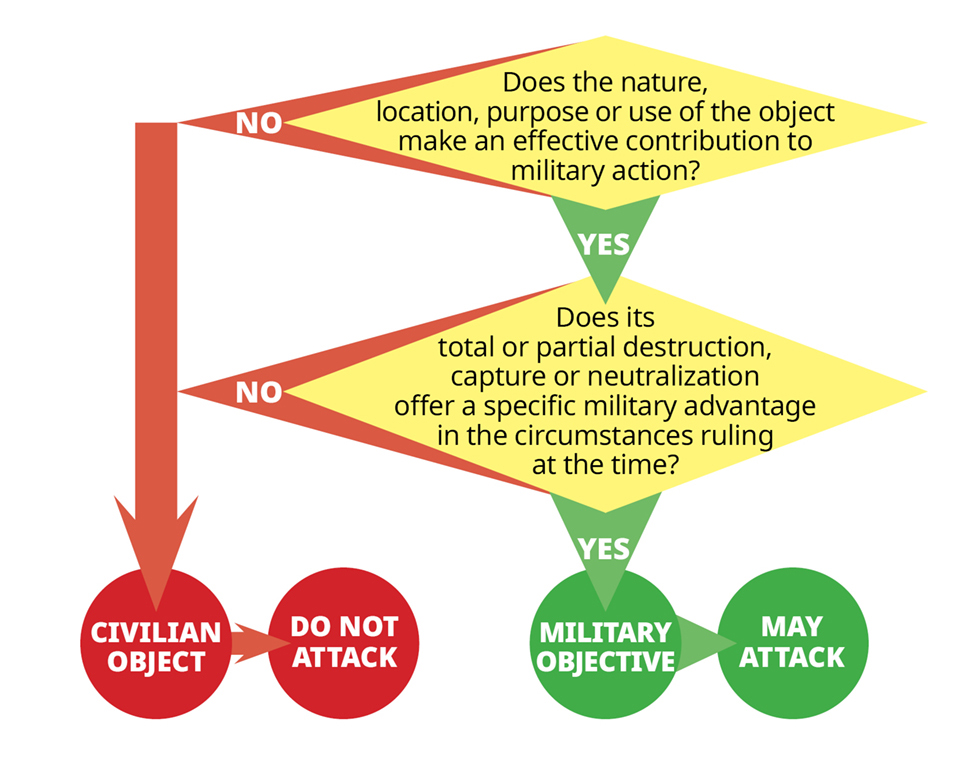Chapter 4 – Objects
Section 1
Introduction
1. In general, every object in an international armed conflict is either a military objective or a civilian object.
2. The status of an object determines the protections that apply to it under LOAC.
Section 2
Military Objectives
Definition
3. A military objective is any object that:
- (1) effectively contributes to enemy military action because of its nature, location, purpose or use; and
- (2) offers a specific military advantage if totally or partially destroyed, captured or neutralized.Footnote 11
4. In general, an object effectively contributes to enemy military action because of its:
- nature if the object is fundamentally military in character (e.g. military weapons, equipment, vehicles and bases);
- location if the land or other area is militarily significant because it must be denied to the enemy or because the enemy must be made to retreat from it (e.g. an enemy staging ground); and
- use or purpose if the enemy uses or intends to use the object for military reasons (e.g. a commercial airfield that the enemy is using or intends to use for military aircraft).Footnote 12
5. The destruction, capture or neutralization of an object generally offers a specific military advantage if there is an honest and reasonable expectation, based on something more than speculation, that military action against the object will make a meaningful contribution to the success of the overall military operation. Military advantage can include a variety of considerations, including the force protection of the attacking armed forces.Footnote 13
Primary Protections
6. Military objectives may be lawfully attacked anywhere and at any time.
Military Medical Establishments
Different rules apply to military medical establishments.
Military medical establishments may not be attacked, with one exception. They may be lawfully attacked if they are used to commit acts of hostility outside their humanitarian function (e.g. a military hospital that the enemy is using as an operational headquarters). However, they may only be lawfully attacked after a warning has been given and ignored.Footnote 14
To reduce the risk of misidentification, medical military establishments will generally display a distinctive emblem consisting of the Red Cross, Red Crescent or Red Crystal (see below). CAF medical establishments display the Red Cross.Footnote 15

Section 3
Civilians Objects
Definition
7. A civilian object is any object that is not a military objective.Footnote 16
Primary Protections
8. Civilian objects may not be attacked.
9. However, if an object that is normally dedicated to civilian purposes is:
- being used in a way that effectively contributes to enemy military action (e.g. a school or a hotel being used as an enemy barracks); and
- offers a specific military advantage if destroyed, captured or neutralized,
the object loses its protection from attack and becomes a military objective. This is the case even in so-called “dual-use” scenarios, where civilians continue to make use of the object (e.g. a bridge being used as a military line of communication, over which civilian traffic continues to pass).
Section 4
Special Cases
10. Stricter rules apply to certain objects of particular humanitarian significance or sensitivity, such as:
- dams, dykes and nuclear power stations;
- foodstuffs, crops, livestock and drinking water;
- hospitals; and
- culturally or spiritually significant monuments, works of art and places of worship.
Dams, dykes and nuclear power stations

Text version: Distinctive emblem
Three orange circles are the distinctive emblems representing dams, dykes and nuclear power stations.
Cultural property

Text version: Distinctive emblem
Half navy blue diamond shape on top of a full navy blue diamond shape is the distinctive emblem representing cultural establishments.
11. Orders and ROE will specify any additional direction and guidance that may be necessary to address these or other special cases in the context of specific operations.
Annex C – Summary Graphic – Objects

Text version: Annex C – Summary Graphic: Objects
Does the nature, location, purpose or use of the object make an effective contribution to military action?
- No
- Civilian Object
- Do Not Attack
- Yes
- Does its total or partial destruction, capture or neutralization offer a definite military advantage in the circumstances ruling at the time?
- No
- Civilian Object
- Do Not Attack
- Yes
- Military Objective
- May Attack
Page details
- Date modified: